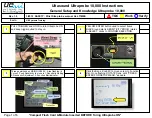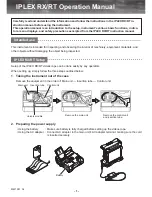
Section 6 — APPLICATIONS GUIDE
6–1
6.1
INTRODUCTION
MODLINE 4 is a precision measuring instrument
built for rugged service and ease of operation.
When installed and maintained with reasonable
care, it will give you reliable, trouble-free service in
a wide variety of applications.
In this section we offer some guidelines to further
ensure accuracy and reliability. We urge you to
review this information to make sure your
instrument gives you the results it is capable of.
BACKGROUND
Make sure the infrared energy being measured is
emitted by the target only. Energy picked up from
some other source is called background. It com-
bines with the true target energy to cause
measurement errors.
Causes of background error are as follows:
•
unresolved targets
•
energy transmitted through the target
•
energy reflected off the surface of the target
Unresolved Targets
An unresolved target can mean any of three
things: (1) the spot size is larger than the target
size, (2) the optical axis of the MODLINE 4 is not
centered on the target, or (3) there is an interfering
object in the sight path. Any of these conditions will
cause the detector to "see" something besides
target radiation and to produce measurement
errors.
To avoid problems: (1) make sure the spot size is
smaller than the target size, (2) aim the MODLINE
4 so its optical axis is centered on the target, and
(3) make sure there are no obstructions in the
sight path. Review Section 2.9 for details.
Emissivity, Reflectance, and Transmittance
An ideal infrared radiator, called a blackbody,
emits the maximum possible amount of infrared
energy when heated to any given temperature. It
has an Emissivity (
ε
) of 1.0. It does not reflect or
transmit background energy (its Reflectance and
Transmittance values are zero).
The MODLINE 4 is factory calibrated using
blackbody standards. However, the targets you
deal with in practice are non-blackbodies. Their
Emissivity values are less than 1.0, which means
they emit some traction of the infrared energy a
blackbody would emit at a given temperature. You
must compensate for this difference by adjusting
the Emissivity (
ε
) control for a setting of less than
1.0.
Non-blackbodies exhibit two potential causes of
background error: Reflectance (
r
) and Transmit-
tance (
τ
).
Reflectance causes the target to act as a mirror,
and it will reflect infrared energy generated by
some other source (e.g., a furnace wall or heater
element). If the MODLINE 4 picks up the reflection,
measurement errors will result.
Reflectance depends on the target material and
the condition of its surface. Flat, smooth surfaces
tend to have larger reflectance values than
roughened surfaces of the same material.
Reflectance problems may be reduced by
changing the viewing angle so that the reflection is
not picked up by the MODLINE 4 or by the use of
sight tubes or some other form of shielding. (See
Fig. 6.1.) Contact IRCON Applications Engineering
for further recommendations.
Transmittance means the target is not completely
opaque at the operating wavelength of the
MODLINE 4, so it may act as a window for infrared
emission from objects behind it (e.g., an oven wall
or heater element).
Transmittance depends on target material and
thickness. For a given material at a given
wavelength, transmittance is inversely related to
thickness.
Transmittance problems are sometimes corrected
by changing the viewing angle so that the
background source is not directly behind the
target, by selecting a different measurement point
away from the background source, or by inserting
a shield behind the workpiece. (See Fig. 6.2 for
examples.) If you are faced with a persistent
transmittance problem, contact IRCON
Applications Engineering for suggestions.
Summary of Contents for Modline 4
Page 3: ......
Page 5: ......
Page 6: ......
Page 34: ......
Page 35: ......
Page 36: ...Section 2 INSTALLATION 2 21 ...
Page 37: ...Section 2 INSTALLATION 2 22 ...
Page 49: ...Section 4 MAINTENANCE SERVICE 4 4 NOTES ...
















































